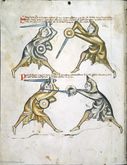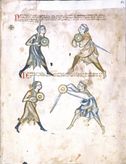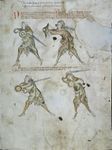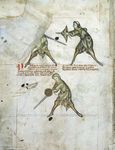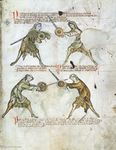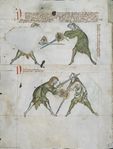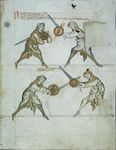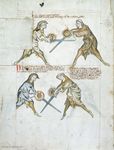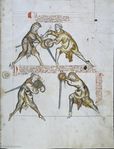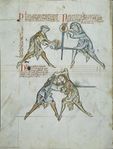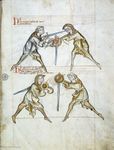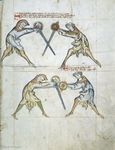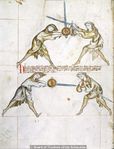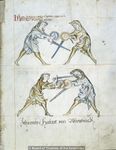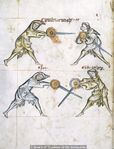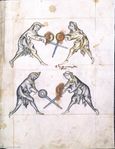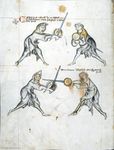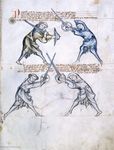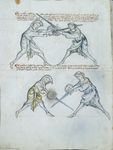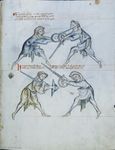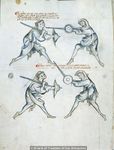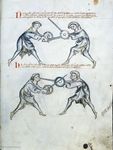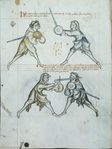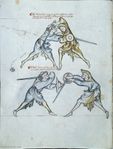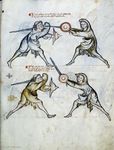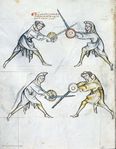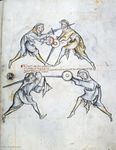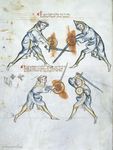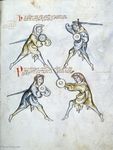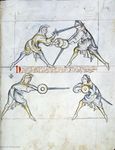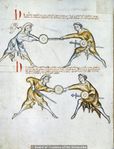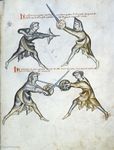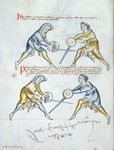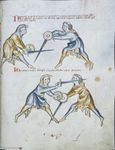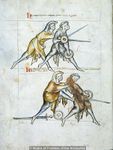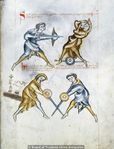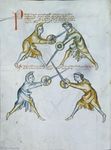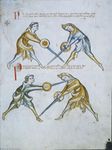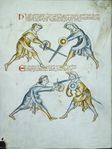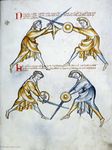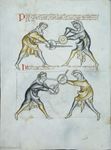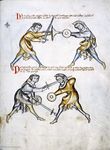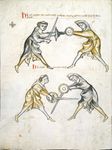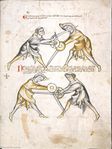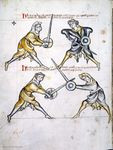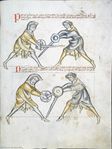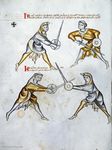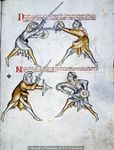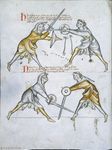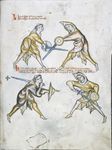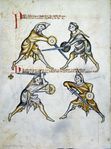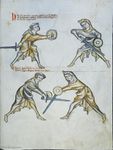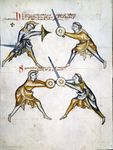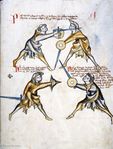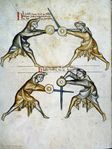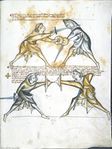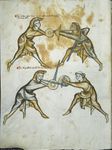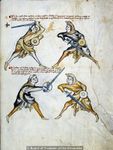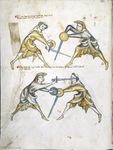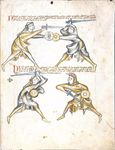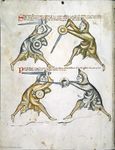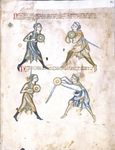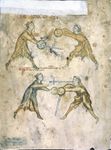|
|
You are not currently logged in. Are you accessing the unsecure (http) portal? Click here to switch to the secure portal. |
Walpurgis Fechtbuch (MS I.33)
| Walpurgis Fechtbuch | |||||
|---|---|---|---|---|---|
| MS I.33, Royal Armouries Leeds, United Kingdom | |||||
| |||||
| |||||
| Also known as |
| ||||
| Type | Fencing manual | ||||
| Date | ca. 1320s | ||||
| Place of origin | Franconia | ||||
| Language(s) | Medieval Latin | ||||
| Ascribed to | Clerus Lutegerus | ||||
| Scribe(s) | Unknown (three hands) | ||||
| Illustrator(s) | Unknown (up to 17 artists) | ||||
| Material | Parchment, in a modern binding | ||||
| Size | 34 folia | ||||
| Format | Double-sided; two illustrations per side with text above and below | ||||
| Script | Bastarda | ||||
| External data | Museum data sheet | ||||
| Treatise scans |
| ||||
| Other translations | |||||
The MS I.33 is a German fencing manual dating to the 1320s.[1] It currently rests in the holdings of the Royal Armouries at Leeds, England. The I.33 is earliest extant writing on Medieval martial arts and the oldest known treatise on swordsmanship, and it appears to have been devised by a secular priest, possibly the "Lutegerus" (or Liutger) mentioned in the text.[2] It was the work of three scribes and potentially as many as 17 illustrators.[3]
The treatise is fully illustrated, and consists of both mnemonic verses and longer explanations in a vernacular Medieval Latin. (The format of verse and gloss may indicate that the priest was recording a much older tradition.) The technique presented is one of two unarmored opponents fencing with arming sword and buckler. This, together with the intriguing fact that the fencers depicted are a priest and a student (and on the last two pages, a priest and a woman identified as St. Walpurga), seems to suggest that the subject matter treated was not a chivalric art, but rather an art of self-defense outside the knightly class. Repeatedly, the text makes mention of the pupils (scolaris/discipulus) of the priest, as well as youths (iuvenis) and clients (clientulum). It seems, therefore, to treat a secular priest who was offering fencing lessons to young men.
The manuscript in its present form consists of five quires, of which all but the first are incomplete; at least eight leaves are believed to be missing (assuming it started with complete quires of four bifolia each).[3] The precise contents of these missing leaves are unknown, but it is possible that they were a source for the thirty uncaptioned sword and buckler plays which appear in the Libri Picture A 83, the Codex I.6.2º.4, and the Cgm 3712; alternatively, these may originate from another manuscript in the same tradition. The anonymous plays seem in turn to have been the primary source for Paulus Hector Mair's treatment of the side sword and buckler, which he captioned with his own interpretations.
Contents
Provenance
The known provenance of the MS I.33 is:
- Written in the 1320s, possibly by a priest named Liutger; owned by Franconian monks until the 1500s.
- 1400s – an additional couplet was inscribed at the top of folio 1r, possibly by Enea Silvio Piccolomini (Pope Pius II; 1405-1464).[citation needed]
- 1552-53 – looted from a monastery by Johannes Herbart von Würzburg during the Franconian campaigns of Albert-Archibald, Duke of Brandenburg-Kulmbach.[4][3] Würzburg was a belt-maker by trade and later served as fencing master to the dukes of Sachsen-Gotha; he inscribed his name on folio 7r.
- before 1579 – possibly duplicated by Heinrich von Gunterrodt while compiling material for his book[4] (such a copy is currently unknown).
- late 1500s-1945 – owned by the dukes of Sachsen-Gotha; listed in an 18th century library catalog as Cod.Membr.I.no.115.[citation needed] The second device on folio 26r was copied into the Codex Guelf 125.16 Extravagante in the 1600s by a scribe who couldn't decipher the Latin text.[5] The manuscript was further described on six leaves of paper (with short excerpts of the text) by Heinrich Niewöhner in 1910. (Lost during World War II.)
- 1945-1950 – location unknown (sold London, Sotheby's, 27 March 1950). Sotheby's listed the manuscript as "a 14th-century manuscript of unknown provenance", and it was not identified as the lost Cod.Membr.I.no.115. until Krämer in 1975.[6]
- 1950-1996 – held by the Royal Armouries and stored in the Tower of London; known variously as "Tower of London Ms. I.33" or "British Museum No. 14 E iii, No. 20, D. vi. I".
- 1996 – moved to the newly-opened Royal Armouries Museum in Leeds.
Contents
|
|
The Royal Armouries' image hosting servers have been down for several weeks, and the collections page now projects that they won't be back up until early 2014. If you need to view the MS I.33 images in the interim, they are mirrored on WikiMedia Commons. |
| Folio | Section | ||||||||||||||||||||||||||||||||||||||||||||||||||||||||||||||||||||||||||||||||||||||||||||||||||||||||||||||||||||||||||||||||||||||||||||||||||||||||
|---|---|---|---|---|---|---|---|---|---|---|---|---|---|---|---|---|---|---|---|---|---|---|---|---|---|---|---|---|---|---|---|---|---|---|---|---|---|---|---|---|---|---|---|---|---|---|---|---|---|---|---|---|---|---|---|---|---|---|---|---|---|---|---|---|---|---|---|---|---|---|---|---|---|---|---|---|---|---|---|---|---|---|---|---|---|---|---|---|---|---|---|---|---|---|---|---|---|---|---|---|---|---|---|---|---|---|---|---|---|---|---|---|---|---|---|---|---|---|---|---|---|---|---|---|---|---|---|---|---|---|---|---|---|---|---|---|---|---|---|---|---|---|---|---|---|---|---|---|---|---|---|---|---|
| 1r - 32v | Sword and buckler, possibly by Liutger
The MS I.33 is a German fencing manual dating to the 1320s.[7] It currently rests in the holdings of the Royal Armouries at Leeds, England. The I.33 is earliest extant writing on Medieval martial arts and the oldest known treatise on swordsmanship, and it appears to have been devised by a secular priest, possibly the "Lutegerus" (or Liutger) mentioned in the text.[8] It was the work of three scribes and potentially as many as 17 illustrators.[3] The treatise is fully illustrated, and consists of both mnemonic verses and longer explanations in a vernacular Medieval Latin. (The format of verse and gloss may indicate that the priest was recording a much older tradition.) The technique presented is one of two unarmored opponents fencing with arming sword and buckler. This, together with the intriguing fact that the fencers depicted are a priest and a student (and on the last two pages, a priest and a woman identified as St. Walpurga), seems to suggest that the subject matter treated was not a chivalric art, but rather an art of self-defense outside the knightly class. Repeatedly, the text makes mention of the pupils (scolaris/discipulus) of the priest, as well as youths (iuvenis) and clients (clientulum). It seems, therefore, to treat a secular priest who was offering fencing lessons to young men. The manuscript in its present form consists of five quires, of which all but the first are incomplete; at least eight leaves are believed to be missing (assuming it started with complete quires of four bifolia each).[3] The precise contents of these missing leaves are unknown, but it is possible that they were a source for the thirty uncaptioned sword and buckler plays which appear in the Libri Picture A 83, the Codex I.6.2º.4, and the Cgm 3712; alternatively, these may originate from another manuscript in the same tradition. The anonymous plays seem in turn to have been the primary source for Paulus Hector Mair's treatment of the side sword and buckler, which he captioned with his own interpretations. ProvenanceThe known provenance of the MS I.33 is:
Contents
GalleryImages hosted by the Royal Armouries. Identification and placement of lost leaves based on work by Dr. Jeffrey L. Forgeng[citation needed] and James Hester.[3] Additional Resources
References
| ||||||||||||||||||||||||||||||||||||||||||||||||||||||||||||||||||||||||||||||||||||||||||||||||||||||||||||||||||||||||||||||||||||||||||||||||||||||||
Gallery
Images hosted by the Royal Armouries. Identification and placement of lost leaves based on work by Dr. Jeffrey L. Forgeng[citation needed] and James Hester.[1]
Additional Resources
- Cinato, Franck and Surprenant, André (in French). Le Livre de l'art du Combat: Liber de arte dimicatoria. Édition critique du Royal Armouries MS. I.33, collection Sources d'Histoire Médiévale nº39. Paris: CNRS Editions, 2009. ISBN 978-2-271-06757-9
- Forgeng, Dr. Jeffrey L. The Illuminated Fightbook Royal Armouries Manuscript I.33. Extraordinary Editions, 2012.
- Forgeng, Dr. Jeffrey L. The Medieval Art of Swordsmanship: A Facsimile & Translation of Europe's Oldest Personal Combat Treatise, Royal Armouries MS I.33 (Royal Armouries Monograph). Chivalry Bookshelf, 2003. ISBN 1-891448-38-2
- Hester, James. A Few Leaves Short of a Quire: Is the ‘Tower Fechtbuch’ Incomplete? Arms & Armour 9 (1): 20–24(5). April 2012. doi:10.1179/1741612411Z.0000000003
- Morini, Andrea and Rudilosso, Riccardo (in Italian). Manoscritto I.33 Rome: Il Cerchio Iniziative Editoriali, 2012.
References
- ↑ Cite error: Invalid
<ref>tag; no text was provided for refs namedHester

